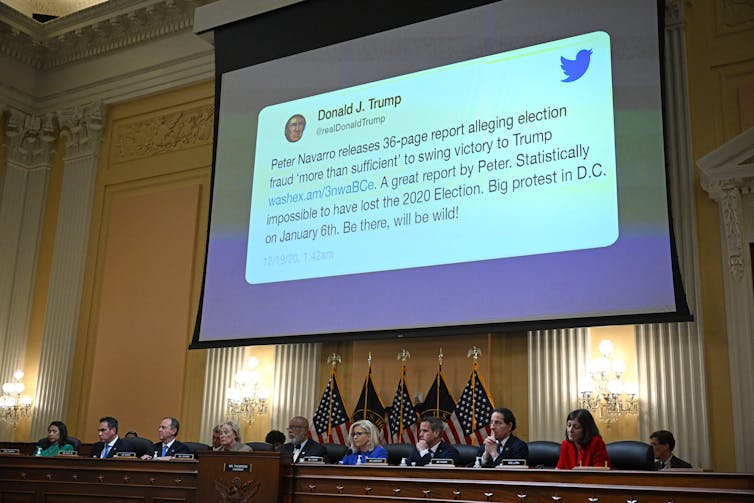The shocking events of Jan. 6, 2021, signaled a major break from the nonviolent rallies that categorized most major protests over the past few decades.
What set Jan. 6 apart was the president of the United States using his cellphone to direct an attack on the Capitol, and those who stormed the Capitol being wired and ready for insurrection.
My co-authors and I, a media and disinformation scholar, call this networked incitement: influential figures inciting large-scale political violence via social media. Networked incitement involves insurgents communicating across multiple platforms to command and coordinate mobilized social movements in the moment of action.
The reason there was not more bloodshed on Jan. 6 emerged through investigation into the Oath Keepers, a vigilante organization composed mostly of former military and police. During their trials for seditious conspiracy, members of the Oath Keepers testified about weapons caches in hotels and vans, stashed near Washington, D.C. As one member described it, “I had not seen that many weapons in one location since I was in the military.”
The Oath Keepers were following Washington law by not carrying the weapons in the district, while waiting for Trump to invoke the Insurrection Act, which gives the president the authority to deploy the military domestically for law enforcement.
The militia was waiting for orders from Trump. That was all that kept U.S. democracy safe from armed warfare that day.

Social media as command and control
What happened in D.C. on Jan. 6, 2021, does not easily fit into typical social movement frameworks for describing mobilization. The insurrectionists behaved akin to a networked social movement, with online platforms forming the infrastructure to organize action, but its leaders were politicians and political operatives as opposed to charismatic community leaders. On that day in particular, the insurrectionists, who are closely aligned with MAGA Republicans more broadly, functioned like Trump’s volunteer army rather than a populist movement.
Even with the availability of social media, networked social movements still need mainstream media coverage to legitimize their cause. Typically, community organizers push a particular issue – for example Black Lives Matter and #MeToo – into the media spotlight to get the public to care about their issue. Social movements tend to struggle for exposure and to frame favorable narratives.
The insurrectionists had the advantage of betting on mainstream media coverage for Jan. 6, so they focused on gathering resources and coordinating attendance. As a result, Trump’s supporters did not need to expend much effort to bring attention to the event and, instead, concentrated on organizing ride-shares and splitting hotel costs. As in prior social movements, the networking capacity of social media proved to be an important conduit to bring strangers together for the occasion. What the insurrectionists failed to do was convince key stakeholders, such as mainstream media, Vice President Mike Pence and the U.S. Capitol Police, to join their fight.
Networked incitement is different from the legalistic understanding of incitement, where an inflammatory statement immediately precedes unlawful acts or creates a dangerous situation. The call to action for Jan. 6 came from the president himself in a series of social media posts enticing supporters to come to D.C. for a “wild” time.
Tweets like these from a prominent figure became social media’s equivalent of shouting fire in a crowded theater.
Mobilizing for violence
My colleagues and I sought data to better understand what motivated everyday folks to storm the Capitol that day under great personal risk. Using the method of qualitative content analysis, we assembled 469 charging and sentencing documents for 417 defendants and coded them for the stated reasons for attending the event. We chose these court documents because they represented the fullest narrative accounts available. The purpose of these documents was to explain the rationales and mental states of the accused, while also offering a defense or explanation for their actions.
We analyzed the documents, looking at the multiple motivations for the insurrectionist mobilization. Overwhelmingly, insurrectionists said they were motivated by a desire to support Trump, which was equally split with a rationale to stop a rigged election. In sum, we concluded that disinformation mobilizes and incites political violence under specific conditions, such as a popular public figure calling for help.
For example, the court documents also directly reference social media posts of the accused. On Dec. 22, 2020, Kelly Meggs, an Oath Keeper who was later convicted of seditious conspiracy and sentenced to 12 years in prison, wrote on Facebook:
“Trump said It’s gonna be wild!!!!!!! It’s gonna be wild!!!!!!! He wants us to make it WILD that’s what he’s saying. He called us all to the Capitol and wants us to make it wild!!! Sir Yes Sir!!! Gentlemen we are heading to DC pack your shit!!”
The reference to “it’s gonna be wild” was a rejoinder to the now infamous tweet Trump sent after a reportedly difficult six-hour meeting the president had with staff about how to proceed with the fraud inquiry and undo the election results. Oath Keeper Meggs’ tweet illustrates that even before Jan. 6, militia groups were looking for signs from Trump about how to proceed. An investigation by NPR also illustrated how Trump’s messages emboldened participants and ignited the events of that day.
A dark future
No sitting president before Trump had exploited the capacity of social media to directly reach citizens to command specific actions.
The use of social media for networked incitement foreshadows a dark future for democracies. Rulers could well come to power by manipulating mass social movements via social media, directing a movement’s members to serve as the leaders’ shock troops, online and off.
Clear regulations preventing the malicious weaponization of social media by politicians who use disinformation to incite violence is one way to keep that future at bay.

